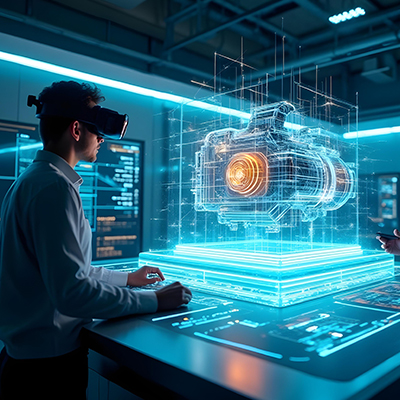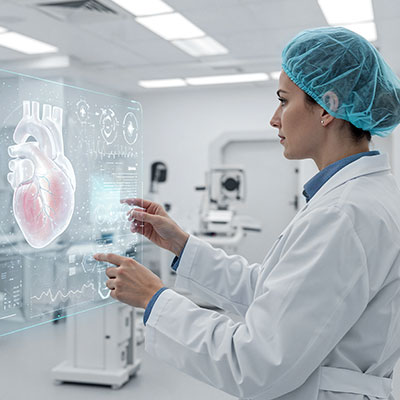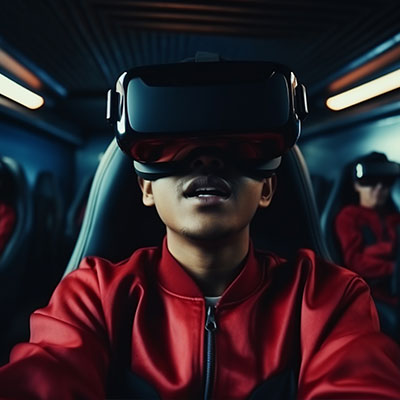Many businesses today struggle to make smart decisions about complex systems without the need for real-world testing of every scenario. Traditional computer simulations often can’t provide the up-to-date, detailed information needed to improve operations, reduce risks, and drive new ideas. This blog explores how VR digital twin technology is revolutionizing real-time simulation by combining immersive environments with data-rich, real-world replicas of physical systems. These technologies work together to create interactive, data-driven solutions that connect virtual models with physical reality, helping businesses predict problems, optimize performance, and innovate with better accuracy and confidence than ever before.
What is a Digital Twin?
A digital twin changes how we understand and work with physical systems. Simply put, a digital twin is a live, virtual copy of a real-world object, system, or process that stays accurate throughout the entire life of that physical thing. What makes digital twins different from regular computer simulations is that they keep a constant, two-way conversation with their real-world partners.
These advanced virtual models get updated continuously with real-time information from sensors, internet-connected devices, and other data sources. This creates a living mirror of the physical item. This real-time connection lets organizations run advanced simulations, make predictions about what might happen, and improve performance in ways that weren’t possible before. Digital twins, as compared to static models or one-way simulations, can collect data from real-world objects and transmit back instructions or insights, forming a feedback loop that supports improved operations and smart decision-making.
Types of Digital Twin
Digital twins are used for various applications and vary in size based on that. Each type meets particular organizational objectives and needs. Organizations can select the best strategy for their unique circumstances and business objectives by being aware of these types.
- Component Twins focus on the smallest pieces, like individual parts, sensors, or components. These twins allow detailed monitoring and simulation of specific elements within larger systems. They offer understanding about how particular parts work, how they wear out, and when they may fail. For example, a temperature sensor in a factory may have its component twin that monitors its performance and forecasts when it requires maintenance.
- Asset or Product Twins combine multiple component twins to model entire products or assets as complete systems. These twins look at how all components work together, giving a complete view of how individual parts contribute to overall system performance. A jet engine digital twin, for instance, would use data from hundreds of component twins to simulate how the entire engine operates.
- System Twins cover groups of assets or products working together as connected systems. These twins help simulate and optimize complex processes that involve multiple assets, helping organizations understand how different parts of their system interact and depend on each other. A manufacturing plant’s digital twin would represent multiple production lines, robots, and support systems all working together.
- Process Twins focus on entire workflows or processes, like manufacturing lines or business processes. These twins optimize efficiency and coordination across multiple systems, showing insights into bottlenecks, how resources are used, and where processes can be improved. They help organizations understand how different processes interact and affect overall performance.
The digital twin also includes special categories based on different life stages.
- Digital Twin Prototypes (DTP) exist before physical products are made, serving as virtual testing grounds for design, testing, and analysis.
- Digital Twin Instances (DTI) represent each unique, manufactured product and stay connected throughout their working lives.
- Digital Twin Aggregates (DTA) combine data from multiple instances to create broader insights and help organizations learn across product lines or system deployments.
How Digital Twins and VR Work Together?
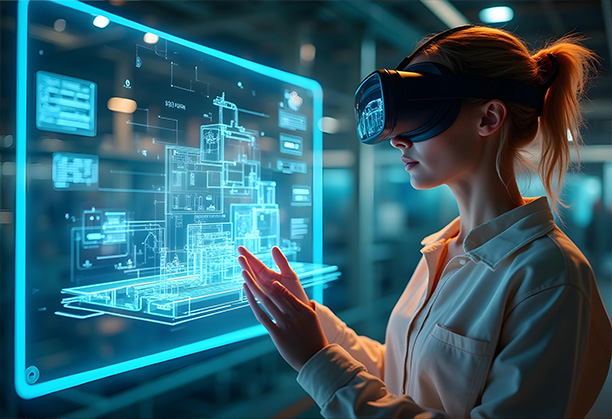
The way people engage with complex data and systems, is transformed through VR digital twin integration, which enables immersive, real-time simulation of environments synced with live operational data. This combination overcomes one of the most difficult issues in traditional simulation: making complex, multi-layered data easier to interpret and apply for human decision-makers.
Immersive visualization is the most obvious benefit of this combination. When digital twins are shown in VR environments, users can literally step inside their data and experience complex systems from viewpoints that would be impossible or dangerous in the real world. Engineers can walk through a virtual factory floor and see real-time production data displayed on equipment, or look inside a jet engine while it’s operating at 30,000 feet. This immersive approach makes understanding easier and enables more natural decision-making, especially for complex systems with many connected parts.
Real-Time Simulation capabilities are significantly enhanced with VR digital twins, allowing users to test scenarios, make changes, and receive instant feedback within immersive 3D replicas of actual systems. Users can change variables, test scenarios, and see results in real-time while keeping VR’s immersive context. This combination enables quick responses to emerging problems, as operators can rapidly simulate different response strategies and see their potential effects before making changes in the real world.
Training and Skill Development benefit greatly from VR-powered digital twins. These environments offer realistic, risk-free spaces where workers can practice complex procedures, emergency responses, or equipment operations using accurate copies of actual systems. The immersive nature of VR combined with the accuracy of digital twins creates training experiences that closely match real-world conditions while removing safety risks and operational disruptions.
Predictive Maintenance and Optimization become more effective when delivered through immersive interfaces. Maintenance technicians can use VR to see predicted failure points, explore the best repair procedures, and practice complex maintenance tasks before working on physical equipment. This approach reduces both the time needed for maintenance activities and the risk of errors during critical repairs.
Industrial Applications of VR Digital Twin
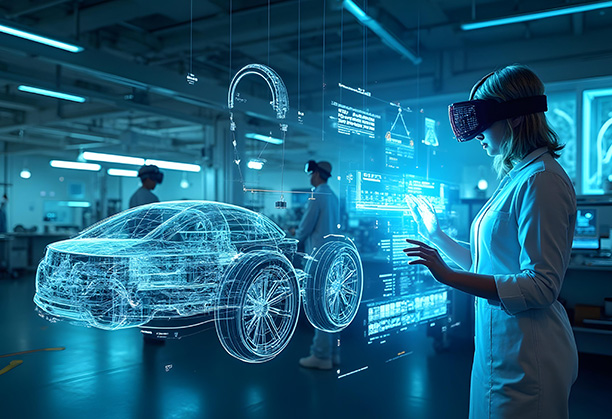
Virtual reality and digital twins are combining to create strong applications in a wide range of industries. These technologies are being used by each industry to solve particular issues and unlock new potential.
Aerospace is one of the most advanced areas of adoption, where precision and safety are critical. Before constructing actual prototypes, engineers may examine intricate assemblies and spot possible issues with VR-enhanced digital twins, which are used by companies such as Boeing and Airbus to see aircraft systems in three dimensions.
Automotive manufacturers have adopted this technology combination to change product development and customer experience. Tesla’s approach of creating digital twins for every vehicle shows how real-time data collection can inform continuous product improvement. VR showrooms powered by digital twins allow customers to experience vehicles in immersive detail, customizing options and exploring features in ways that traditional showrooms cannot match.
Manufacturing has seen the widest adoption of digital twins and VR integration. Smart factories use these technologies for optimizing facility layouts, simulating robot operations, and providing immersive virtual reality training for operators. Digital twin in manufacturing offers predictive maintenance programs that allow technicians to see equipment health data and practice repair procedures in virtual environments that mirror their actual work environments.
Energy sector applications focus heavily on safety and remote operations. Oil and gas companies use VR-enhanced digital twins for immersive training on offshore platforms, allowing workers to practice emergency procedures without the risks of actual offshore training. Power generation facilities use these technologies for design walkthroughs and safety simulations, helping engineers optimize plant layouts and identify potential hazards before construction begins.
Retail and Luxury Goods industries are using these technologies to create entirely new customer experiences. High-end brands create virtual showrooms where customers can interact with products in incredible detail. At the same time, digital twins enable real-time customization and personalization that would be impossible with physical samples alone.
Healthcare applications, while still developing, show great promise for surgical planning and medical training. Digital twins of organs or medical devices, combined with VR visualization, help surgeons practice complex procedures and develop patient-specific treatment approaches using accurate anatomical models.
Digital Twin Examples
Leading organizations across industries are showing the powerful impact of digital twins through real-world implementations that deliver measurable business results.
Tesla has pioneered the concept of complete vehicle digital twins, where every car produced maintains a digital counterpart throughout its entire lifecycle. This approach enables continuous improvement in vehicle design, predictive maintenance for owners, and production optimization based on real-world performance data. The insights generated from these digital twins inform both current vehicle servicing and future product development.
Boeing shows how digital twins can transform complex manufacturing processes. Their implementation has achieved an 80% reduction in assembly time and a 50% decrease in software development time, showing how virtual testing and optimization can dramatically speed up physical production processes.
Unilever has implemented digital twins across its global factory network to simulate production processes, optimize efficiency, and maintain consistent product quality regardless of manufacturing location. This approach enables rapid knowledge transfer between facilities and ensures that improvements developed at one location can be quickly implemented across their entire manufacturing network.
BMW reduces manufacturing errors and accelerates the development of new car features by using digital twins for manufacturing process simulation and optimization. Their strategy demonstrates how digital twins may help with both innovation acceleration and operational excellence.
Airbus has achieved considerable improvements in aircraft production efficiency by implementing digital twins, including a 20% reduction in rework. Throughout the development phase, their digital twins replicate the performance of airplanes and facilitate predictive maintenance plans that enhance aircraft safety and availability.
Future Trends
The evolution of digital twins and VR integration points toward several major trends that will reshape real-time simulation capabilities and their applications across industries.
Self-Updating and AI-Driven Twins are the next step toward autonomous system administration. Future digital twins will use artificial intelligence more and more to learn from operational data, modify their models without human assistance, and make ever-more-complex predictions and suggestions. As a result of this development, digital twins will be able to increase in accuracy over time and require less human labor to update and maintain virtual models.
Twin-as-a-Service models will make digital twin capabilities more accessible to enterprises by providing advanced simulation and modeling tools via cloud-based subscription services. Smaller businesses will be able to acquire enterprise-grade digital twin capabilities without having to make large upfront investments.
Metaverse Integration will embed digital twins within permanent virtual environments, allowing for new forms of collaboration, training, and remote work. These integrated settings will help worldwide teams collaborate in shared virtual spaces that precisely depict physical systems and allow for real-time collaboration on difficult tasks.
Hyper-Personalization will emerge as digital twins become advanced enough to model individual preferences, behaviors, and needs. This capability will enable unprecedented levels of customization in products, services, and experiences, from personalized medical treatments to individually optimized urban transportation systems.
Sustainability and Circular Economy applications will use digital twins to optimize resource use, minimize waste, and support circular economy principles. Organizations will use these technologies to design products for recyclability, optimize energy consumption, and minimize environmental impacts throughout product lifecycles.
Ready to transform your operations with cutting-edge VR digital twin technology?
How Juego neXR Supports VR Digital Twin Solutions
Juego neXR stands at the forefront of digital twin and VR integration, offering comprehensive solutions that bridge the gap between complex data and actionable insights. We specialize in creating immersive digital twin experiences that transform how organizations visualize, interact with, and optimize their physical assets and processes. Our expertise spans multiple industries, from manufacturing and aerospace to healthcare and energy.
Our team works closely with clients to develop custom digital twin solutions that integrate seamlessly with existing systems while providing intuitive VR interfaces that make complex data accessible to all stakeholders. We understand that every organization has unique requirements, which is why our approach focuses on scalable, tailored solutions that grow with your business needs.
Conclusion
The VR digital twin model is fundamentally reshaping the future of real-time simulation by merging immersive interfaces with live data environments, delivering smarter decisions, faster responses, and safer training. This powerful pairing transforms how organizations understand, interact with, and optimize complex systems across every industry and application area. As AI-driven automation, cloud accessibility, and metaverse integration continue to evolve, organizations that invest in digital twin and VR capabilities today will be positioned to lead in an increasingly digital world, redefining what’s possible in prediction, optimization, and innovation while creating new possibilities for human creativity and problem-solving that blur the boundaries between virtual and physical reality.
Frequently Asked Questions
Digital twins maintain continuous, two-way communication with physical objects through real-time data feeds, while traditional simulations use static models. Digital twins update automatically with sensor data and can send insights back to physical systems, enabling predictive analytics and dynamic optimization that regular simulations cannot provide.
Manufacturing, aerospace, automotive, and energy sectors see the highest returns due to complex operations and safety requirements. However, healthcare, retail, and smart cities are rapidly adopting these technologies. Any industry with complex systems, equipment maintenance needs, or training requirements can benefit significantly.
Most organizations see initial benefits within 6-12 months of implementation, with full ROI typically achieved within 18-24 months. Companies like Siemens and Boeing report immediate productivity improvements, while predictive maintenance benefits often appear within the first few months of operation.
While initial setup requires technical expertise, modern digital twin platforms are designed for ease of use. Most staff can learn to operate VR interfaces with minimal training.
Revolutionize the future of business with Juego neXR
Related Posts
Share this Article:
Our Offices

India
Bangalore
GR Grand Plaza, 2nd Floor, JP Nagar, 6th Phase, Bangalore – 560 078

KSA
Jeddah
St Idris Square, 4036 Helmi Koutbi, Al Zahra, Jeddah 23425, Saudi Arabia
Follow Us On:
© 2025 Juego neXR. All Rights Reserved.
